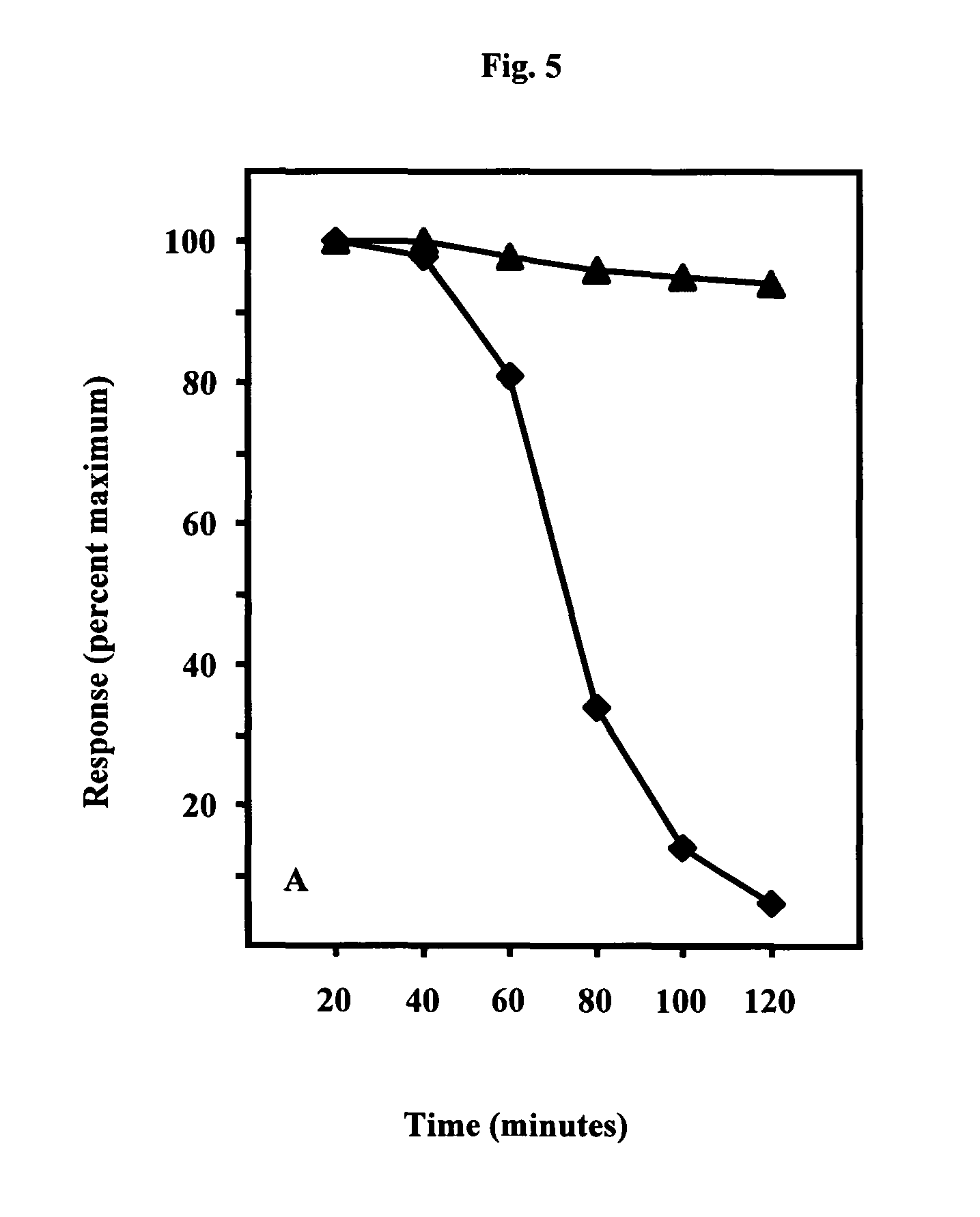Mutant botulinum neurotoxin serotype a polypeptide and uses thereof
a botulinum neurotoxin and polypeptide technology, applied in the field of botulinum neurotoxin polypeptide serotype, can solve the problems of carrying a potential risk, not a desirable characteristic of a vaccine candidate, delivery vehicle,
- Summary
- Abstract
- Description
- Claims
- Application Information
AI Technical Summary
Benefits of technology
Problems solved by technology
Method used
Image
Examples
example 1
Preparation of BoNT / A HC50 Molecules
[0157]BoNT / A HC50 domain, and a series of single (His1253Trp; Trp1266Leu; and Tyr1267Ser) and double (Trp1266Leu / Tyr1267Ser) point mutant variations thereof, were generated as follows.
[0158]SEQ ID NO: 9 is the amino acid sequence for a heavy chain of BoNT / A. SEQ ID NO: 9 is an 846 amino acid polypeptide whose sequence corresponds to residues 451 to 1296 of the BoNT / A propolypeptide (strain 62A). The HC50 fragment used in the examples is a 432 amino acid polypeptide whose sequence corresponds to residues 865 to 1296 of the BoNT / A propolypeptide and to residues 415 to 846 of SEQ ID NO: 9. The gene portion encoding the HC50 fragment of BoNT / A (strain 62A) was cloned into 6×His vector pQE30 (Qiagen; Valencia, Calif.) yielding the expression plasmid pQEHC50A. The resultant HC50 polypeptide is fused to a six histidine tag sequence.
[0159]Escherichia coli [BL21-codon plus(DE3)-RIL (Stratagene)] was used as a host strain for expression of HC50 domains. Cel...
example 2
[0169]A transcytosis assay for wild type BoNT / A HC50 and Trp1266Leu / Tyr1267Ser dimutant BoNT / A HC50 (SEQ ID NO:14) transport across epithelial cells was carried out essentially as described by Maksymowych and Simpson, J. Pharmacol. Exp. Ther. 310:633-641, 2004, using T-84 human epithelial cells.
[0170]T84 cell cultures were prepared by growing T-84 in a 1:1 mixture of Dulbecco's modified Eagle's medium (1 g / l D-glucose) and Ham's F-12 nutrient medium supplemented with 5% newborn calf serum, 100 U / ml penicillin, 100 mg / ml streptomycin, 8 μg / ml ampicillin, and 15 mM HEPES. Cultures were maintained at 37° C. in 6% CO2. T-84 cells were fed every other day and passaged (1:2) when 95% confluent, approximately every 4 to 5 days. Passages 75 through 85 were used for the following experiments.
[0171]For the transcytosis assay, T-84 cells were plated at confluent density (ca. 1.5×105 cells) into Transwells with 0.5 ml of medium in the upper chamber and 1.0 ml in the lower cham...
example 3
Neuromuscular Bioassay of Wild Type BoNT / A HC50
[0172]The most sensitive site for botulinum toxin activity in the periphery is the cholinergic neuromuscular junction. The isolated HC50 domain retains affinity for neuromuscular junctions, and this affinity is typically quantified by measuring the ability of the polypeptide to antagonize the actions of the parent toxin. The ability of HC50 domains to compete for toxin binding sites may therefore be bioassayed with phrenic nerve-hemidiaphragm preparations as follows. This functional assay ensures that the HC50 activity being quantified is relevant to the neuroparalytic actions of the parent toxin.
[0173]Murine phrenic-nerve hemidiaphram preparations were excised and placed in tissue baths to bioassay the toxicity of botulinum toxin in biological specimens, according to the procedures of Kiyatkin et al., Infect. Immun. 65:4586-4591, 1997 and Park and Simpson, Infect. Immun. 71:1147-1154, 2003. Tissues were suspended in physiological buffe...
PUM
| Property | Measurement | Unit |
|---|---|---|
| Fraction | aaaaa | aaaaa |
| Fraction | aaaaa | aaaaa |
| Fraction | aaaaa | aaaaa |
Abstract
Description
Claims
Application Information
 Login to View More
Login to View More - R&D
- Intellectual Property
- Life Sciences
- Materials
- Tech Scout
- Unparalleled Data Quality
- Higher Quality Content
- 60% Fewer Hallucinations
Browse by: Latest US Patents, China's latest patents, Technical Efficacy Thesaurus, Application Domain, Technology Topic, Popular Technical Reports.
© 2025 PatSnap. All rights reserved.Legal|Privacy policy|Modern Slavery Act Transparency Statement|Sitemap|About US| Contact US: help@patsnap.com



